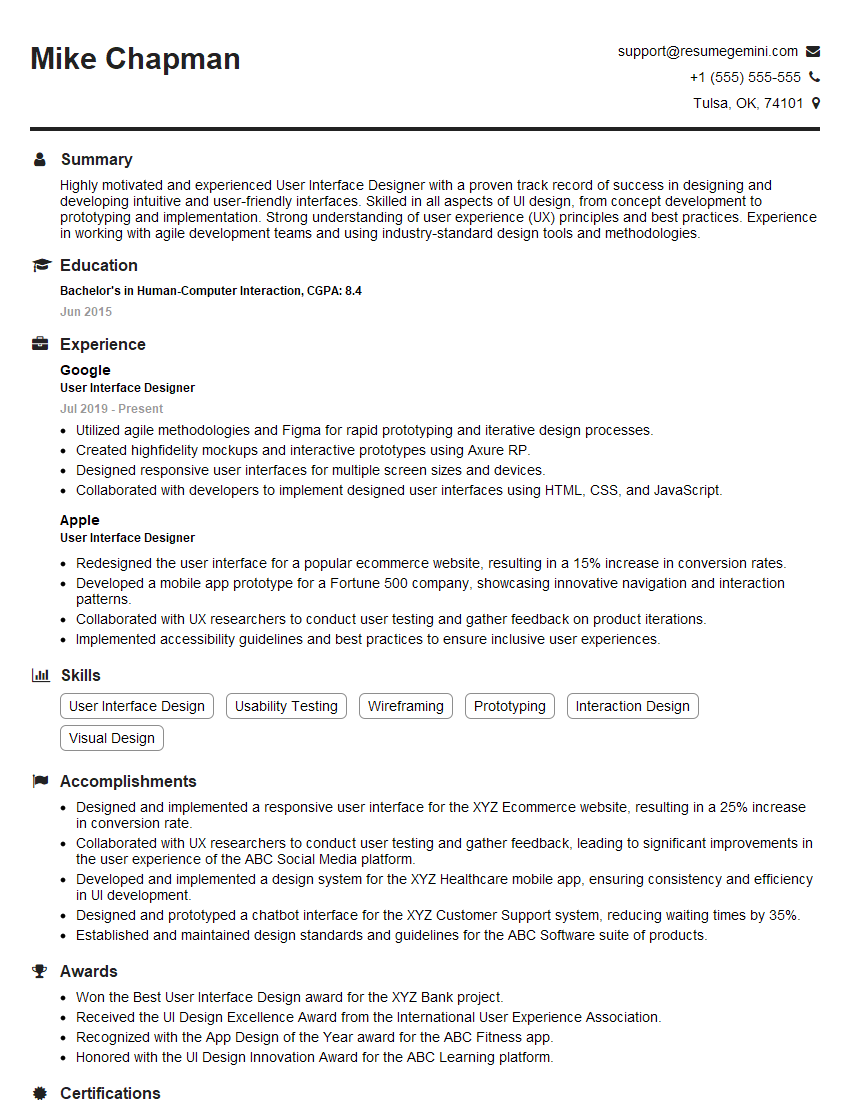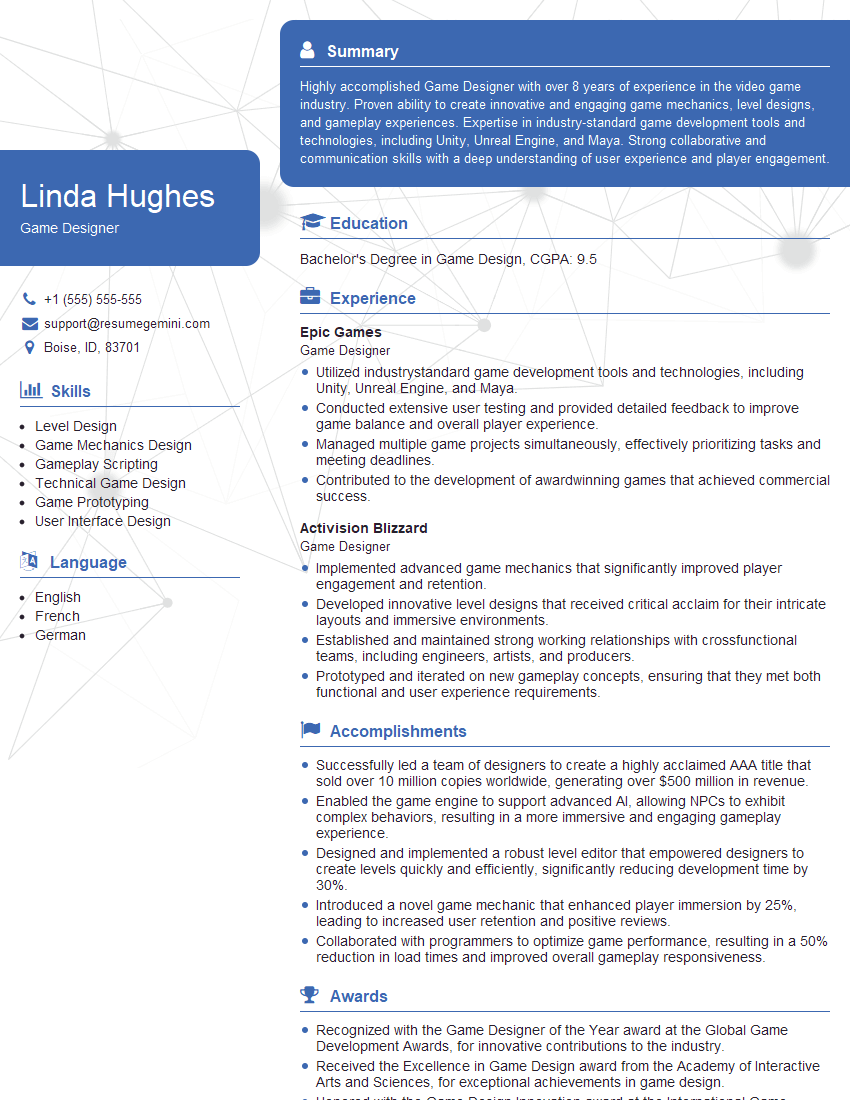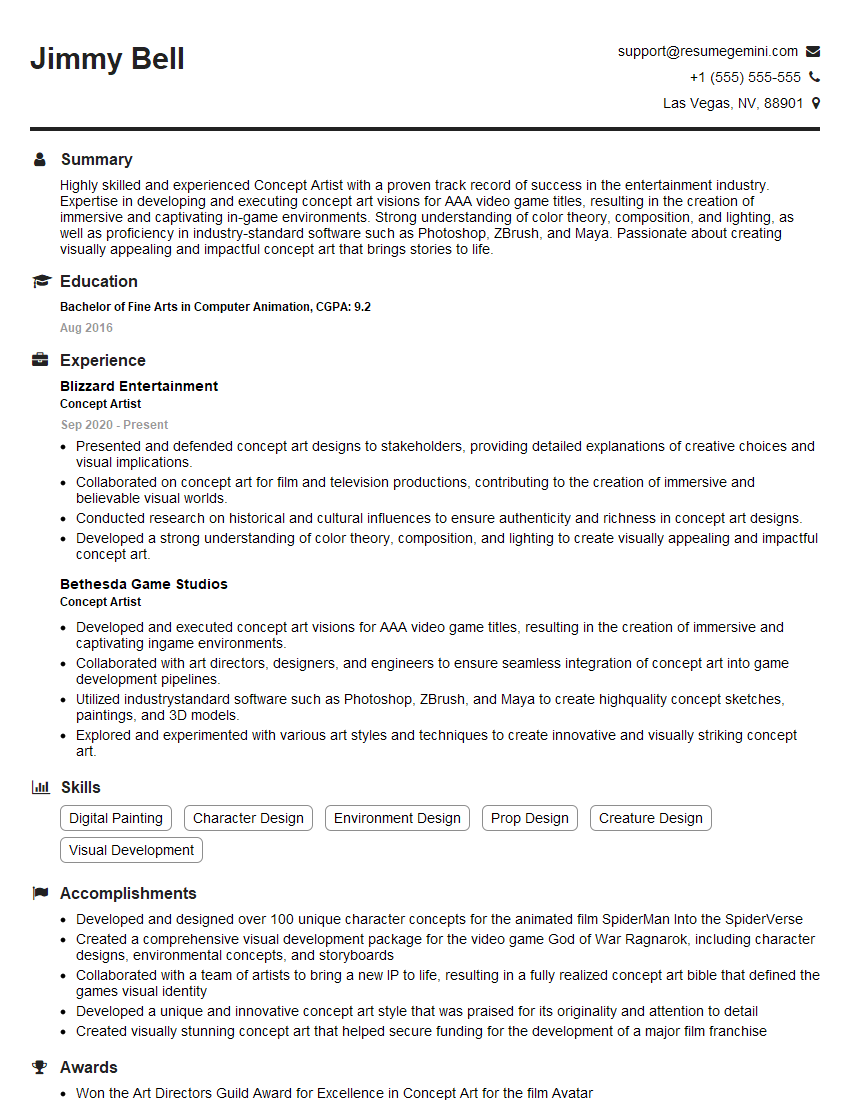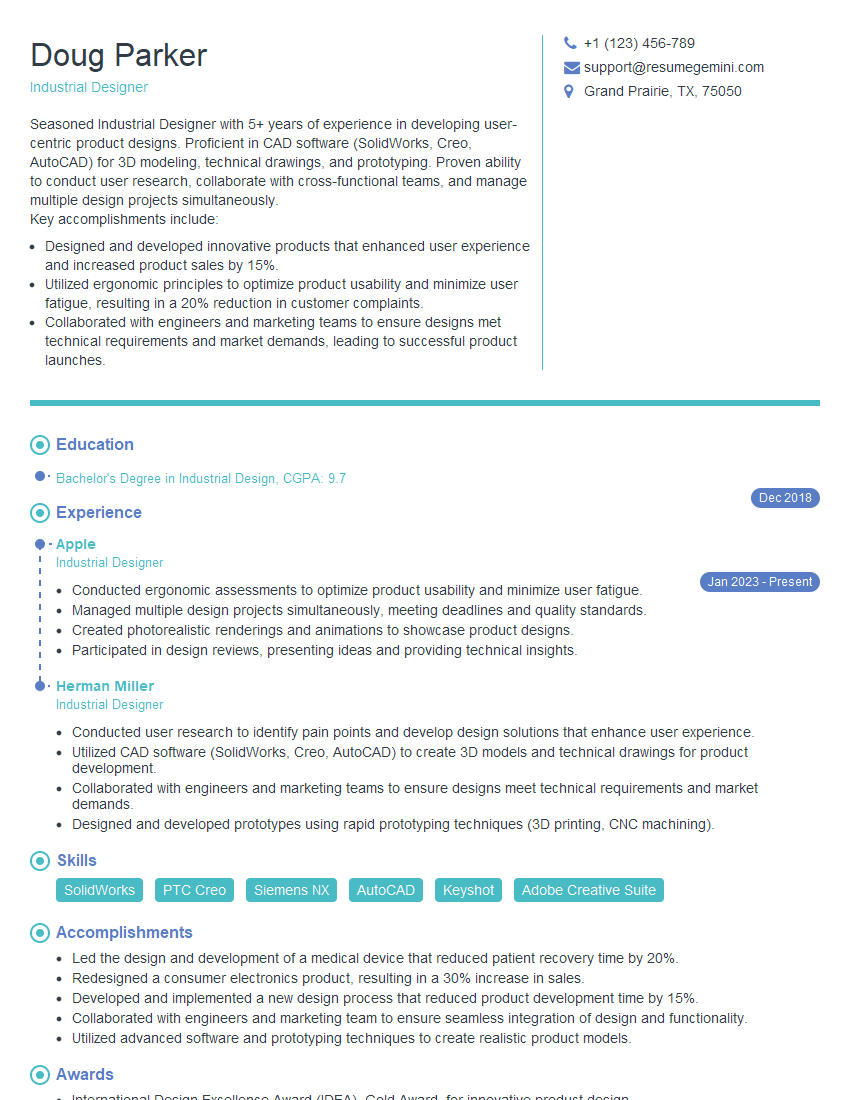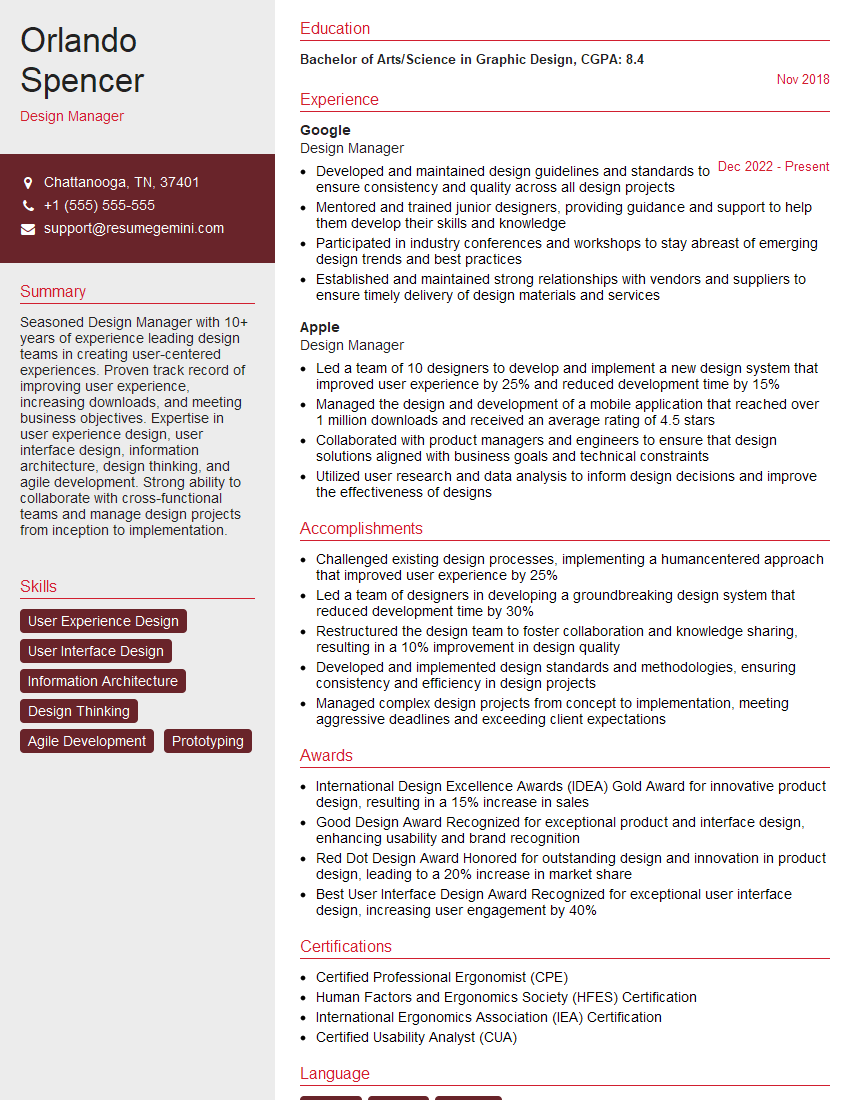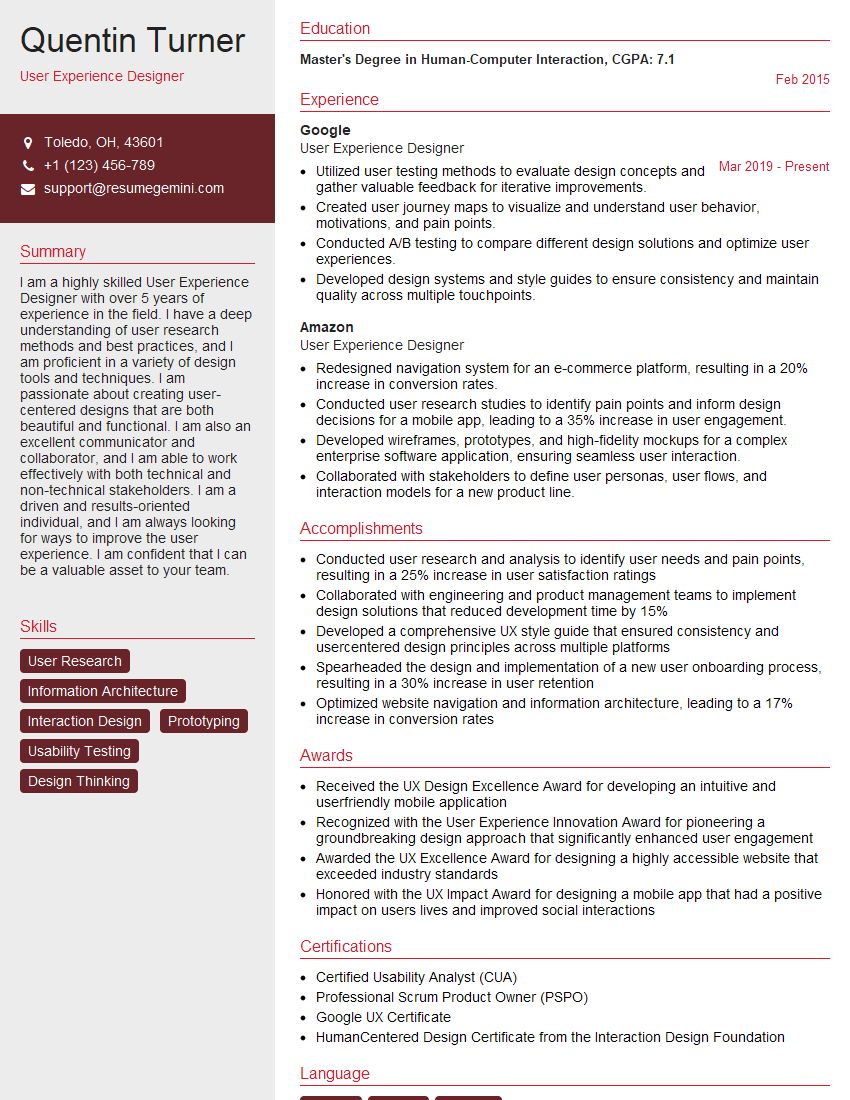Preparation is the key to success in any interview. In this post, we’ll explore crucial Design Concept Development interview questions and equip you with strategies to craft impactful answers. Whether you’re a beginner or a pro, these tips will elevate your preparation.
Questions Asked in Design Concept Development Interview
Q 1. Explain your process for developing a design concept from initial brief to final presentation.
My design concept development process is iterative and user-centric. It begins with a thorough understanding of the design brief, which involves clarifying the project goals, target audience, and constraints. I then move into the research phase, gathering insights through user interviews, surveys, and competitive analysis. This informs the ideation stage, where I generate multiple concepts through sketching and brainstorming. These concepts are then refined through prototyping and user testing, incorporating feedback to iterate and improve the design. The final presentation showcases the refined concept, supported by research findings and design rationale.
- Brief Analysis: Deconstructing the brief to identify key requirements and potential challenges.
- Research & Analysis: Conducting user research and competitive analysis to inform design decisions.
- Ideation & Sketching: Generating a range of design concepts through brainstorming and sketching.
- Prototyping & Testing: Creating low-fidelity and high-fidelity prototypes for user testing and feedback.
- Iteration & Refinement: Incorporating feedback to refine and improve the design concept.
- Final Presentation: Presenting the final design concept with supporting documentation and rationale.
For example, in designing a new mobile banking app, I’d start by understanding user needs for security, ease of use, and transaction speed. This research would guide the design of intuitive navigation, clear visual hierarchy, and robust security features.
Q 2. Describe your experience with user research and how it informs your design concepts.
User research is foundational to my design process. I employ a mixed-methods approach, combining quantitative and qualitative data to gain a comprehensive understanding of user needs and behaviors. This might involve conducting user interviews to understand their frustrations and pain points with existing solutions, or running A/B tests to compare the effectiveness of different design choices. The insights gathered inform every stage of the design process, from initial ideation to final refinement. For example, discovering that users struggle with a specific feature during usability testing would lead me to redesign that feature for improved clarity and ease of use.
- User Interviews: Understanding user needs, pain points, and expectations.
- Surveys: Gathering quantitative data on user preferences and behaviors.
- Usability Testing: Observing users interacting with prototypes to identify areas for improvement.
- A/B Testing: Comparing the effectiveness of different design choices.
- Competitive Analysis: Benchmarking against existing solutions to identify best practices and opportunities for innovation.
Imagine designing a website for an e-commerce store. User research might reveal that customers are frustrated by a lengthy checkout process. This informs the design of a streamlined, user-friendly checkout experience.
Q 3. How do you handle conflicting design requirements from stakeholders?
Conflicting stakeholder requirements are inevitable. I address them through a collaborative and communicative approach. This involves facilitating workshops or meetings to discuss the different perspectives, prioritize requirements based on user needs and business goals, and identify potential compromises. I utilize tools such as priority matrices and decision-making frameworks to guide the process and ensure transparency. The goal is to find a balanced solution that addresses the core needs while mitigating conflicting priorities.
- Facilitated Workshops: Bringing stakeholders together to discuss and resolve conflicts.
- Prioritization Matrices: Ranking requirements based on importance and feasibility.
- Decision-Making Frameworks: Utilizing structured approaches to resolve disagreements.
- Transparent Communication: Keeping stakeholders informed throughout the process.
- Compromise & Negotiation: Finding mutually acceptable solutions that address core needs.
For example, if one stakeholder wants a highly complex feature while another prioritizes simplicity, I’d facilitate a discussion to understand the rationale behind each preference and explore alternatives that might satisfy both.
Q 4. Explain your approach to sketching and prototyping during the concept development phase.
Sketching and prototyping are integral parts of concept development. Sketching allows for rapid iteration and exploration of various design ideas, helping to visualize and communicate concepts quickly. I often start with low-fidelity sketches on paper to explore different layouts and interactions, followed by digital prototyping using tools like Figma or Adobe XD. Prototypes range from low-fidelity wireframes illustrating basic functionality to high-fidelity mockups mimicking the final product’s look and feel. These prototypes are invaluable for user testing and gathering feedback.
- Low-Fidelity Sketching: Rapidly exploring different design options.
- Digital Prototyping: Creating interactive prototypes for user testing.
- Wireframing: Illustrating basic functionality and layout.
- Mockups: Creating high-fidelity representations of the final design.
- Interactive Prototypes: Simulating user interactions to test functionality.
For a mobile app, I might start with paper sketches of different screen layouts before moving to a digital prototype that allows users to simulate navigation and interactions.
Q 5. How do you evaluate the feasibility of a design concept?
Evaluating the feasibility of a design concept involves considering various factors: technical feasibility (can it be built with the available technology and resources?), economic feasibility (is it cost-effective to develop and maintain?), and user feasibility (will users actually adopt and use it?). I conduct thorough technical assessments, cost estimations, and user testing to assess these aspects. This evaluation informs the decision to proceed with the chosen concept or to explore alternative options.
- Technical Feasibility: Assessing the availability of technology and resources.
- Economic Feasibility: Estimating the cost of development and maintenance.
- User Feasibility: Assessing user acceptance and usability through testing.
- Risk Assessment: Identifying potential challenges and mitigation strategies.
- Resource Allocation: Determining the required resources (time, budget, personnel).
For example, a design concept relying on cutting-edge technology not yet mature enough might be deemed technically infeasible. Similarly, a design that requires excessive development time and resources might be economically infeasible.
Q 6. Describe a time you had to iterate on a design concept due to feedback or testing.
During a recent project redesigning a company’s website, initial user testing revealed significant confusion around the navigation. Users struggled to find specific information, resulting in high bounce rates. Based on this feedback, we iterated on the design, simplifying the navigation menu, improving visual hierarchy, and adding clearer calls to action. We then conducted further user testing to validate these changes. This iterative process significantly improved user experience and reduced bounce rates.
The key was embracing the feedback, adapting our design, and then testing again. This cyclical process, typical in design, ensured that the final product effectively met user needs.
Q 7. How do you stay up-to-date with current design trends and technologies?
Staying current with design trends and technologies is crucial. I actively participate in online communities, attend industry conferences and workshops, and follow influential designers and publications. I regularly explore new design tools and technologies, experimenting with them in personal projects to understand their capabilities. This continuous learning ensures that I apply the latest best practices and innovative solutions in my work.
- Industry Conferences & Workshops: Attending events to network and learn from experts.
- Online Communities: Engaging in discussions and sharing knowledge with other designers.
- Design Publications & Blogs: Following industry leaders and staying informed on new trends.
- Experimentation with New Tools & Technologies: Hands-on experience with the latest software and techniques.
- Continuous Learning: Regularly expanding knowledge and skillset through online courses and workshops.
For example, exploring the latest advancements in AI-powered design tools helps me incorporate innovative solutions into my design process and improve efficiency.
Q 8. What design software are you proficient in?
My proficiency in design software spans a range of tools, each chosen for its strengths in different stages of the design process. I’m highly proficient in Figma for its collaborative features and prototyping capabilities, particularly useful in iterative design sprints. I also use Adobe Photoshop for high-fidelity image editing and Adobe Illustrator for vector graphics and logo design. For 3D modeling and prototyping, I leverage Blender, a powerful open-source tool. Finally, I use Sketch occasionally for specific UI design projects that require its unique feature set. My skillset allows me to adapt to the project’s specific needs and choose the most appropriate tool for optimal results.
Q 9. How do you incorporate user feedback into your design process?
Incorporating user feedback is paramount to creating successful designs. My approach is multifaceted and begins early in the design process. I conduct user research using methods like surveys, interviews, and usability testing to understand user needs and pain points. This feedback informs the initial concept sketches and prototypes. Throughout the design process, I use iterative prototyping, showing users low-fidelity mockups and gathering their feedback before moving to higher fidelity prototypes. I utilize tools like Figma’s prototyping features and user testing platforms to gather quantitative and qualitative data. This iterative feedback loop ensures the design continuously evolves to meet user expectations. I then analyze the feedback, prioritizing critical issues and iterating on the design until a satisfactory solution is achieved. A crucial element is ensuring clear communication and documentation of all feedback and design changes.
Q 10. Explain your understanding of design thinking principles.
Design thinking is a human-centered problem-solving approach that focuses on understanding user needs and creating innovative solutions. It’s a five-stage process:
- Empathize: Deeply understanding the user’s needs, motivations, and challenges through research and observation.
- Define: Clearly articulating the problem to be solved based on the research findings. This involves framing the problem concisely and identifying key constraints.
- Ideate: Brainstorming and generating a wide range of potential solutions, encouraging creativity and out-of-the-box thinking. Techniques like sketching, mind mapping, and brainstorming sessions are utilized.
- Prototype: Creating tangible representations of the solutions, ranging from rough sketches to functional prototypes. This allows for testing and refinement.
- Test: Evaluating the prototypes with users to gather feedback and iterate on the design. This stage is crucial for validation and improvement.
I apply design thinking principles to every project, ensuring the solution is not just aesthetically pleasing but also effectively addresses the user’s needs and solves the underlying problem. For instance, in designing a new mobile app, I would start by interviewing potential users to understand their current workflows and pain points (Empathize), then define the core problem the app aims to solve (Define). I would then brainstorm different app features and functionalities (Ideate), create interactive prototypes (Prototype), and test those prototypes with users to refine the design (Test).
Q 11. Describe your experience with different design methodologies (e.g., Agile, Waterfall).
My experience encompasses both Agile and Waterfall methodologies. Waterfall, with its linear, sequential approach, is suitable for projects with well-defined requirements and minimal anticipated changes. I’ve used it effectively in projects where specifications were clear upfront, allowing for a structured, predictable process. Agile, on the other hand, is better suited for projects with evolving requirements and a need for flexibility. I’ve successfully employed Agile methodologies, particularly Scrum, in projects that required iterative development and frequent feedback integration. The iterative nature of Scrum allows for adjustments based on user feedback and changing market conditions. My choice of methodology depends heavily on the project’s complexity, the client’s needs, and the level of uncertainty involved. Regardless of the methodology, I emphasize clear communication, collaboration, and a focus on delivering value at each stage.
Q 12. How do you balance aesthetics and functionality in your designs?
Balancing aesthetics and functionality is crucial for creating successful designs. It’s not a compromise but rather a harmonious integration. I approach this by starting with a deep understanding of the user needs and the functionality required. The design should be intuitive and easy to use. Once the core functionality is defined, I focus on creating a visually appealing and engaging design. This involves choosing appropriate colors, typography, and imagery that complement the functionality without distracting from it. User experience (UX) principles guide this process, ensuring a smooth and enjoyable interaction. For example, a visually stunning website might fail if its navigation is confusing. Conversely, a functional website with poor aesthetics might repel users. Successful design achieves a synergy where both aspects contribute to a positive user experience.
Q 13. How do you ensure your design concepts are accessible to diverse users?
Accessibility is a fundamental aspect of my design process. I ensure designs are usable by people with diverse abilities. This involves adhering to accessibility guidelines like WCAG (Web Content Accessibility Guidelines). I consider factors like:
- Color contrast: Ensuring sufficient contrast between text and background colors for users with visual impairments.
- Keyboard navigation: Making sure all interactive elements are accessible using only a keyboard.
- Screen reader compatibility: Using appropriate semantic HTML and ARIA attributes to ensure compatibility with screen readers used by visually impaired users.
- Alternative text for images: Providing descriptive alternative text for images so screen readers can convey the image’s content.
- Captioning and transcripts: Providing captions for videos and transcripts for audio content.
These considerations are incorporated throughout the design process, from initial concept development to final implementation. Regular testing with users representing diverse abilities is vital to ensure the design meets accessibility standards and provides an inclusive experience for everyone.
Q 14. Describe a design concept you’re particularly proud of and why.
I’m particularly proud of the design concept I developed for a mobile application aimed at assisting visually impaired individuals with navigation. The app utilized a combination of haptic feedback, audio cues, and simplified UI design to provide intuitive navigation instructions. The challenge was to create an experience that was both informative and unobtrusive, avoiding information overload. We achieved this through carefully crafted audio signals that corresponded to directional changes and proximity to points of interest. Haptic feedback provided additional confirmation, while the streamlined UI ensured a clear and uncluttered interface. The app’s success lies in its user-centered approach; extensive user testing with visually impaired individuals informed every stage of the design process, from the initial ideation to the final testing. The positive feedback and the demonstrable improvements in user navigation validated the concept and its positive impact, making it a project I’m particularly proud of.
Q 15. How do you measure the success of a design concept?
Measuring the success of a design concept isn’t solely about aesthetics; it’s about achieving the project’s goals. We use a multi-faceted approach, combining quantitative and qualitative data.
- Quantitative Metrics: This includes things like user engagement (website traffic, app downloads, time spent on-site), sales figures (if applicable), and cost-effectiveness (was the design achieved within budget?). For example, if we’re designing a website, a successful outcome would be a significant increase in leads or sales after the launch compared to the previous design.
- Qualitative Metrics: This involves user feedback through surveys, usability testing, and focus groups. We look at things like user satisfaction, ease of use, and how well the design communicates the intended message. For a packaging design, qualitative success might mean positive customer reviews praising its aesthetics and practicality.
- Meeting Objectives: Ultimately, the success is measured against the initial brief and project goals. Did the design achieve the client’s objectives? Did it solve the problem it was intended to solve? This requires consistent communication and a clear understanding of the client’s vision from the beginning.
By combining these approaches, we get a holistic view of the design’s effectiveness and areas for potential improvement.
Career Expert Tips:
- Ace those interviews! Prepare effectively by reviewing the Top 50 Most Common Interview Questions on ResumeGemini.
- Navigate your job search with confidence! Explore a wide range of Career Tips on ResumeGemini. Learn about common challenges and recommendations to overcome them.
- Craft the perfect resume! Master the Art of Resume Writing with ResumeGemini’s guide. Showcase your unique qualifications and achievements effectively.
- Don’t miss out on holiday savings! Build your dream resume with ResumeGemini’s ATS optimized templates.
Q 16. What are some common challenges you face during design concept development?
Design concept development often faces several hurdles. Some common challenges include:
- Client Communication & Feedback: Misunderstandings or conflicting client feedback can derail a project. Managing expectations and establishing clear communication channels is crucial.
- Technical Limitations: The proposed design might not be feasible due to technological limitations or budget constraints. Finding creative solutions within these limitations is essential.
- Time Constraints: Tight deadlines can compromise the quality of the design process. Effective time management and prioritization are vital.
- Balancing Aesthetics and Functionality: A design needs to be both visually appealing and user-friendly. Striking this balance requires careful consideration and iterative testing.
- Unclear Design Brief: Starting with a poorly defined brief can lead to confusion and a final product that misses the mark. Thorough initial discussions and a well-structured brief are paramount.
Overcoming these challenges requires strong communication, problem-solving skills, and a willingness to adapt and iterate.
Q 17. How do you handle pressure and tight deadlines?
Handling pressure and tight deadlines requires a structured and proactive approach. I utilize several strategies:
- Prioritization: I break down large tasks into smaller, manageable chunks, prioritizing the most critical elements first. This ensures that even under pressure, we make progress on the most important aspects.
- Time Management Techniques: I use time-blocking and project management tools to schedule tasks effectively and track progress. This prevents getting overwhelmed and ensures deadlines are met.
- Effective Communication: Open communication with the team and clients helps manage expectations and identify potential roadblocks early on. Transparency is key to successfully navigating tight deadlines.
- Delegation: Where possible, I delegate tasks to team members, optimizing our collective skills and efficiency.
- Stress Management: Maintaining a healthy work-life balance is vital. I prioritize breaks, exercise, and other stress-reducing activities to maintain focus and productivity.
Ultimately, a calm and organized approach, coupled with clear communication, is the most effective way to navigate pressure and deliver high-quality work under tight deadlines.
Q 18. Explain your experience with creating mood boards and style guides.
Mood boards and style guides are essential tools in my design process. A mood board is a visual representation of the design’s overall aesthetic, capturing the feeling and tone. It’s a collaborative tool, helping to visualize the project’s direction and ensuring everyone is on the same page.
For example, for a project designing a coffee shop, the mood board might include images of rustic wood textures, vintage coffee grinders, warm lighting, and calming earth tones. This ensures that the design reflects the intended ambiance of the shop.
A style guide, on the other hand, is a more detailed document that outlines the specific design elements used throughout the project. This includes typography, color palettes, imagery styles, and branding guidelines. It provides consistency and helps maintain a unified brand identity across all platforms.
I create style guides that are comprehensive and easy to use, including examples of each element. The level of detail in a style guide varies depending on the project’s complexity. For a simple logo design, a basic guide might suffice. However, a large brand redesign would necessitate a very detailed and comprehensive style guide.
Q 19. Describe your approach to presenting design concepts to clients or stakeholders.
Presenting design concepts requires a structured approach that clearly communicates the design’s value proposition. I typically follow these steps:
- Preparation: I carefully craft a presentation that showcases the design’s key features and benefits, using compelling visuals and data to support the design decisions.
- Storytelling: Instead of just presenting the visuals, I weave a narrative around the design, explaining the design process, the challenges faced, and the solutions implemented. This helps clients understand the rationale behind the design choices.
- Interactive Presentation: I encourage interaction and discussion during the presentation, answering questions and addressing concerns promptly. This allows for collaborative feedback and refinement.
- Prototypes and Mockups: Presenting interactive prototypes or mockups allows clients to experience the design firsthand, gaining a deeper understanding of its usability and functionality.
- Post-Presentation Follow-up: I always follow up with a comprehensive summary of the presentation and next steps. This ensures clarity and continued engagement.
The goal is not simply to show the design, but to engage the client, demonstrate the design’s effectiveness, and build consensus.
Q 20. How do you incorporate sustainability considerations into your design concepts?
Sustainability is a crucial consideration in contemporary design. I integrate sustainable practices throughout the design process by considering:
- Material Selection: Opting for eco-friendly materials like recycled paper, bamboo, or sustainably sourced wood. For digital designs, considering the environmental impact of data storage and transmission.
- Energy Efficiency: Designing for energy efficiency, such as incorporating energy-saving features in architectural designs or optimizing website performance for reduced energy consumption.
- Waste Reduction: Minimizing waste during the production process through efficient material use and design for disassembly. For packaging design, using minimal packaging or easily recyclable materials.
- Durability and Longevity: Designing products and systems that are durable and long-lasting, reducing the need for frequent replacements.
- Lifecycle Assessment: Considering the entire lifecycle of a product or system, from material sourcing to disposal, to identify potential environmental impacts and mitigate them.
By incorporating these aspects, we create designs that are not only aesthetically pleasing but also environmentally responsible.
Q 21. How do you handle criticism of your design concepts?
Criticism is an inevitable part of the design process. I view it as an opportunity for growth and improvement. My approach to handling criticism includes:
- Active Listening: I listen attentively to the criticism, seeking to understand the perspective of the critic. This requires patience and empathy.
- Seeking Clarification: If the criticism is unclear, I ask clarifying questions to ensure I understand the concerns fully.
- Objective Evaluation: I objectively evaluate the criticism, separating constructive feedback from personal opinions. Not all criticism is valid or helpful.
- Responding Professionally: I respond professionally and respectfully, even if I disagree with the criticism. I acknowledge the feedback and explain my design rationale.
- Iterative Refinement: Based on constructive criticism, I refine the design, incorporating improvements where appropriate. This demonstrates a commitment to excellence and client satisfaction.
By embracing criticism and viewing it as a valuable tool for improvement, we create better designs and strengthen client relationships.
Q 22. Describe your experience with A/B testing and its role in concept development.
A/B testing, also known as split testing, is a crucial method in concept development. It involves presenting two or more variations of a design element (e.g., a button color, headline text, or layout) to different user groups and analyzing which version performs better based on metrics like click-through rates or conversion rates. In concept development, this allows us to validate design choices objectively rather than relying solely on intuition.
For example, I was once tasked with designing a landing page for a new software product. We created two versions: one with a bold, primary call-to-action button, and another with a more subtle call-to-action. Using A/B testing, we discovered that the bolder button resulted in a 20% higher conversion rate, providing crucial data to inform the final design.
The process typically involves defining clear metrics, segmenting users, creating variations, running the test, and meticulously analyzing the results to understand what worked and what didn’t. This iterative process allows us to refine the design concept, optimize user experience, and ultimately increase the effectiveness of the final product.
Q 23. How do you ensure brand consistency across different design concepts?
Maintaining brand consistency across different design concepts is paramount. It’s about creating a unified and recognizable brand identity that resonates with the target audience. This involves establishing a comprehensive brand style guide, which serves as a central repository for all brand assets, including logo usage, typography, color palettes, imagery styles, and voice and tone guidelines.
For instance, if designing a website and a mobile app for the same brand, the style guide ensures both adhere to the same logo variations, color schemes, and typography, reinforcing brand recognition. We use design systems, which are essentially libraries of reusable components, to achieve consistency in elements like buttons, input fields, and navigation menus across platforms. Each component is carefully designed and documented according to the brand style guide, guaranteeing consistent visual presentation and user experience across all projects. This systematic approach reduces design inconsistencies and allows designers to work efficiently, focusing on new creative solutions while maintaining brand integrity.
Q 24. What is your process for identifying and addressing potential design flaws?
Identifying and addressing design flaws is an iterative process involving several steps. Firstly, I employ usability testing, where real users interact with the design prototypes and their experiences are observed and recorded. We focus on identifying pain points, usability issues, and areas for improvement. Secondly, heuristic evaluation, a systematic review based on established usability principles (Nielsen’s heuristics are commonly used), helps identify potential problems overlooked during usability testing. Finally, I utilize accessibility audits to ensure the design meets accessibility standards, guaranteeing inclusivity for users with disabilities.
For example, during a recent project, usability testing revealed users struggled to find a crucial feature due to poor placement. Heuristic evaluation then pinpointed the issue as a violation of the ‘visibility of system status’ principle. By relocating the feature based on this feedback, we addressed both usability and accessibility concerns. The process often involves prototyping, testing, iterating, and retesting until the flaws are addressed and the design is refined.
Q 25. Explain your understanding of design patterns and best practices.
Design patterns are reusable solutions to common design problems. They are pre-defined templates for UI elements and interactions, offering a structured approach to design. Best practices, on the other hand, encompass broader guidelines and recommendations, such as ensuring accessibility, responsiveness, and clarity in the user interface.
Understanding these is essential for efficiency and quality. For example, using a ‘modal dialog’ pattern for confirmations, or following best practices like using clear and concise microcopy improves usability. Common design patterns include navigation menus, search bars, and forms; best practices may include prioritizing accessibility, ensuring cross-browser compatibility, and adhering to established design systems. By effectively utilizing established design patterns and best practices, designers can create consistent, user-friendly and efficient interfaces.
Q 26. How do you ensure your design concepts are scalable and adaptable?
Scalability and adaptability are crucial considerations in design concept development. Scalable designs can handle increasing amounts of data or user traffic without significant performance degradation. Adaptable designs can easily be modified or extended to accommodate future changes or new requirements.
To achieve this, I employ modular design, where the interface is broken down into smaller, independent components. This allows for easy modification and expansion without affecting the entire system. For example, a website’s navigation menu can be easily updated without redesigning the entire page. Responsive design techniques, ensuring the design adapts to different screen sizes (desktops, tablets, and mobile devices), are also key. Utilizing flexible layouts and media queries in CSS ensures seamless adaptation across various platforms and screen sizes. Choosing technology and frameworks that support scalability and adaptability from the outset is also essential. This strategy ensures the design is robust, maintainable, and future-proof.
Q 27. How do you balance innovation and practicality in your design work?
Balancing innovation and practicality is a delicate act. Innovation drives progress and creates unique experiences, but practicality ensures the design is feasible, usable, and cost-effective. I find that a user-centric design approach helps achieve this balance. This involves thoroughly understanding the user’s needs and context before introducing innovative ideas.
For instance, a highly innovative design might involve groundbreaking technology but fail if it’s not user-friendly or compatible with existing systems. Therefore, I carefully evaluate the feasibility of innovative ideas against constraints like budget, time, and technology before integrating them. The result is a design that is both inventive and realistic, providing a positive user experience without jeopardizing the project’s viability. Iterative design processes, where we test and refine the concept based on feedback, are also critical for finding this sweet spot.
Q 28. Describe your experience with working collaboratively on design projects.
Collaboration is essential in design. My experience includes working closely with cross-functional teams, including developers, product managers, marketers, and stakeholders. I believe in open communication, active listening, and constructive feedback.
I utilize tools like collaborative design platforms (Figma, InVision) that allow for real-time feedback and design iterations. Regular team meetings and presentations, coupled with thorough documentation of design decisions and rationale, are vital in ensuring everyone is on the same page. I also proactively seek diverse perspectives during the design process, understanding that a collaborative effort leads to more innovative and inclusive solutions. A recent project involved extensive collaboration with developers to ensure the designed user interface was technically feasible and to implement the design efficiently. This collaborative approach resulted in a successful product launch on time and within budget.
Key Topics to Learn for Design Concept Development Interview
- Understanding Design Briefs & Client Needs: Analyzing project requirements, identifying target audiences, and translating abstract ideas into actionable design strategies.
- Ideation & Brainstorming Techniques: Exploring diverse approaches to problem-solving, utilizing various brainstorming methodologies (e.g., mind mapping, SCAMPER), and effectively generating innovative design concepts.
- Sketching & Visual Communication: Developing strong sketching skills to rapidly translate ideas into visual form, communicating design concepts clearly and concisely through visual representation.
- Concept Refinement & Iteration: Critically evaluating initial concepts, incorporating feedback, and iteratively refining designs based on research, user testing, and stakeholder input.
- Storyboarding & User Flows: Creating compelling narratives through storyboarding, illustrating user journeys and interactions to effectively communicate the design’s functionality and user experience.
- Presentation & Communication Skills: Articulating design decisions and rationales clearly and persuasively, tailoring presentations to different audiences (e.g., clients, developers, stakeholders).
- Design Research & User Experience (UX) Principles: Applying UX principles to inform design decisions, conducting user research to understand user needs and behaviours, and ensuring designs are user-centered and accessible.
- Software Proficiency (Relevant to Role): Demonstrating proficiency in design software relevant to the specific role (e.g., Figma, Adobe Creative Suite, Sketch).
- Design Thinking Process: Understanding and applying the design thinking framework to tackle complex design challenges systematically.
Next Steps
Mastering Design Concept Development is crucial for career advancement in the creative industries. It demonstrates your ability to translate abstract ideas into tangible solutions and collaborate effectively within design teams. To maximize your job prospects, focus on creating a compelling and ATS-friendly resume that highlights your skills and experience. ResumeGemini is a trusted resource to help you build a professional resume that stands out. We provide examples of resumes tailored to Design Concept Development to guide you through the process. Take advantage of these resources to showcase your talents effectively and land your dream job!
Explore more articles
Users Rating of Our Blogs
Share Your Experience
We value your feedback! Please rate our content and share your thoughts (optional).
What Readers Say About Our Blog
Hi, I’m Jay, we have a few potential clients that are interested in your services, thought you might be a good fit. I’d love to talk about the details, when do you have time to talk?
Best,
Jay
Founder | CEO


